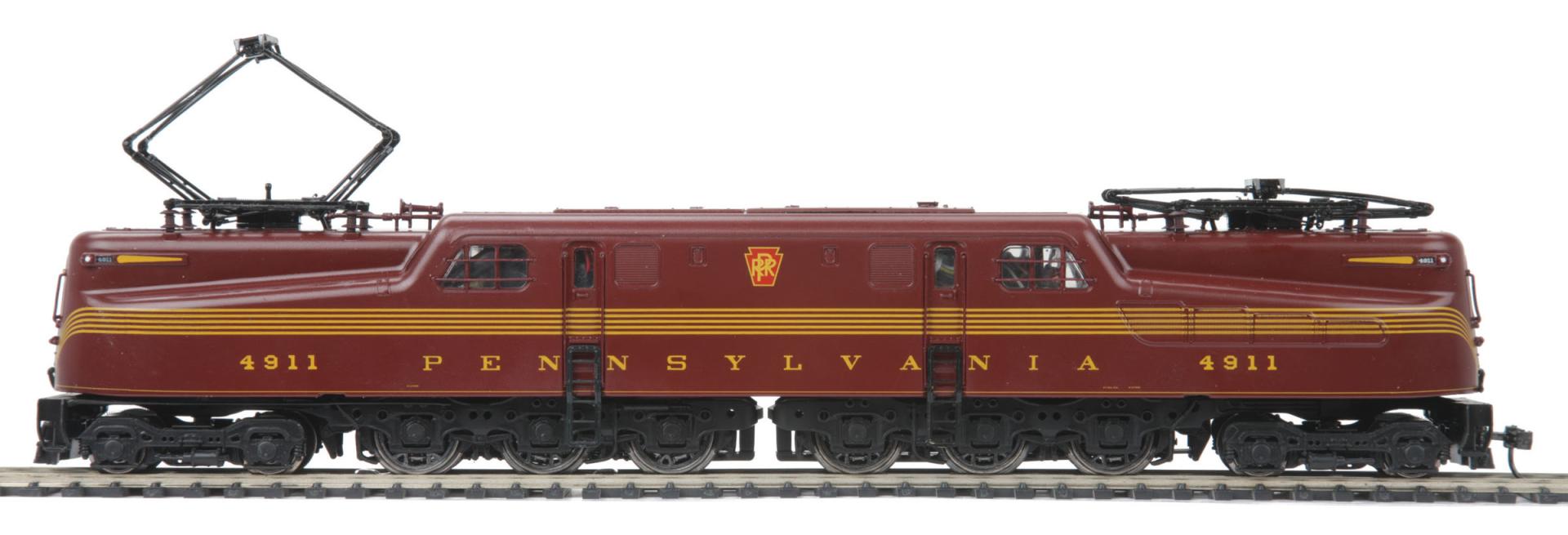

Pennsylvania HO Scale MTH HO GG-1 Electric with Proto-Sound 3.0
Overview
The GG1 fleet hustled passenger traffic of all types along the Pennsy's multi-track raceway from New York to Washington and west to Harrisburg, including the famed Congressional and Broadway Limited. With 18 Pullmans in tow, a GG1 could hit 100 mph. Regeared for freight service and run as double-headers, a pair of GG1s delivered about the same tractive effort as a Union Pacific Big Boy, with virtually no noise, no smoke, much less wear on the track, and significantly less maintenance. Many GG1s racked up more than five million miles of service, outlasting the railroad that built them and serving its two successors, the Penn Central and Conrail. If there were a Locomotive Hall of Fame, the Pennsylvania Railroad GG1 would surely be one of the first inductees.
Add this fully die-cast Hall of Famer to your layout as a complete set or in one or more authentic PRR liveries, featuring station sounds for Pennsy name trains, smooth performance at any speed from a crawl to full throttle, a powerful 12-Volt 5-Pole precision skew-Wound flywheel equipped motor to rival the prototype, and pantographs that automatically raise and lower according to the direction of travel.
Automatic Pantograph Operation Explained
Users operating the GG-1 in conventional mode will find that by depressing the transformer's direction button to stop the locomotive, the rear pantograph will remain in the up position while the lead pantograph slowly rises up. Once the lead pantograph is in its up position, the rear pantograph will slowly lower into the down position. At this point another press of the direction button will cause the locomotive to reverse making the lead pantograph now the rear pantograph and in the up position.
In command operation two operating modes will be offered; auto and manual. Auto mode will behave similar to conventional mode with the rear pantograph in the up position when moving. The up and down movement of the pantograph will be direction controlled using the DCS Digital Command Control System. In Manual mode, the user will have to raise and lower both pantographs via the DCS System or any 28-Function DCC system as they wish regardless of directional state.
Features
Proto-Sound 3.0 equipped locomotives can be controlled in command mode with any DCC compliant command control system. While the user won't have access to all of the incredible features of Proto-Sound 3.0, independent control over the locomotive is possible. This means you can continue to use your existing DCC controller to independently control your other DCC equipped locomotives in addition to your Proto-Sound 3.0 locomotive on the same track at the same time.
When using a DCC controller, the following Proto-Sound 3.0 locomotive features are accessible:
- F0 Headlight
- F1 Bell
- F2 Whistle/Horn
- F3 Start Up/Shut Down
- F4 Rear Coupler
- F5 Front Coupler
- F6 Engine Sounds On/Off
- F7 Sound Volume
- F8 Ditch Lights Auto/On/Off
- F9 Forward Signal
- F10 Reverse Signal
- F11 Grade Crossing Signal
- F12 Cab Light On/Off
- F13 Extended Start Up
- F14 Extended Shut Down
- F15 Rev Up
- F16 Rev Down
- F17 Coupler Slack Sound
- F18 Coupler Close
- F19 One-Shot Doppler
- F20 Feature Reset
- F21 Idle Sequence 1
- F22 Idle Sequence 2
- F23 Idle Sequence 3
- F24 Ditch Lights Auto/On/Off
- F25 Brakes Auto/Off
- F26 Cab Chatter Auto/Off
- F27 Clickety-Clack Auto/Off
- F28 Coupler Slack Sound
- Proto-Sound 3.0 With The Digital Command System Featuring: Passenger Station Proto-Effects
- Unit Measures:11 5/16" x 1 3/8" x 2 7/16"
- Operates On 18" Radius Curves
